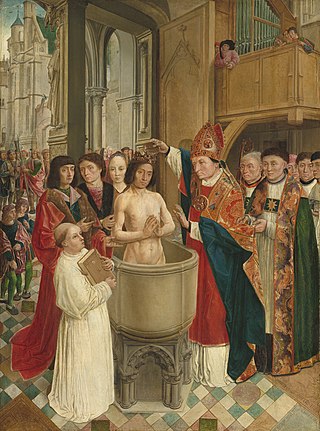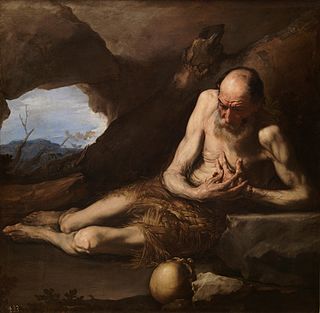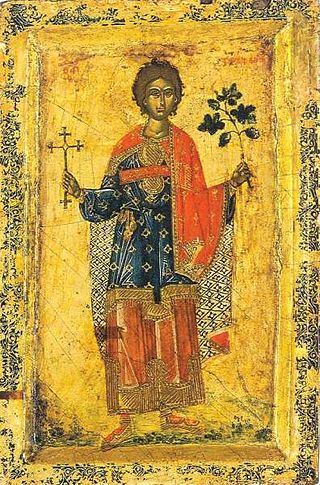
Hilary of Arles, also known by his Latin name Hilarius, was a bishop of Arles in Southern France. He is recognized as a saint by the Roman Catholic and Eastern Orthodox Churches, with his feast day celebrated on 5 May.
Ado of Vienne was archbishop of Vienne in Lotharingia from 850 until his death and is venerated as a saint. He belonged to a prominent Frankish family and spent much of his early adulthood in Italy. Several of his letters are extant and reveal their writer as an energetic man of wide sympathies and considerable influence. Ado's principal works are a martyrology, and a chronicle, Chronicon sive Breviarium chronicorum de sex mundi aetatibus de Adamo usque ad annum 869.

Remigius was the Bishop of Reims and "Apostle of the Franks". On 25 December 496, he baptised Clovis I, King of the Franks. The baptism, leading to about 3000 additional converts, was an important event in the Christianization of the Franks. Because of Clovis's efforts, a large number of churches were established in the formerly pagan lands of the Frankish empire, establishing a distinct Catholic variety of Christianity for the first time in Germanic lands, most of whom had been converted to Arian Christianity.

Mar. 31 - Eastern Orthodox liturgical calendar - Apr. 2

April 12 - Eastern Orthodox liturgical calendar - April 14

May 22 - Eastern Orthodox Church calendar - May 24
A martyrology is a catalogue or list of martyrs and other saints and beati arranged in the calendar order of their anniversaries or feasts. Local martyrologies record exclusively the custom of a particular Church. Local lists were enriched by names borrowed from neighbouring churches. Consolidation occurred, by the combination of several local martyrologies, with or without borrowings from literary sources.

Paul of Thebes, commonly known as Paul the First Hermit or Paul the Anchorite, was an Egyptian saint regarded as the first Christian hermit and grazer, who was claimed to have lived alone in the desert of Thebes, Roman Egypt from the age of sixteen to the age of one hundred and thirteen years old. He was canonized in 491 by Pope Gelasius I, and is venerated as a saint by the Catholic Church, Eastern Orthodox Church, and Oriental Orthodox Churches.
Saint Didier, also known as Desiderius, was a Merovingian-era royal official of aristocratic Gallo-Roman extraction.

Simeon at the Temple is the "just and devout" man of Jerusalem who, according to Luke 2:25–35, met Mary, Joseph, and Jesus as they entered the Temple to fulfill the requirements of the Law of Moses on the 40th day from Jesus' birth, i. e. the presentation of Jesus at the Temple.

Alexander of Jerusalem was a third century bishop who is venerated as a martyr and saint by the Eastern Orthodox Church, Oriental Orthodox churches, and the Roman Catholic Church. He died during the persecution of Emperor Decius.

Saint Tryphon of Campsada was a 3rd-century Christian saint. He is venerated by the Roman Catholic and Eastern Orthodox churches as a great martyr and holy unmercenary.
The Archbishopric of Vienne, named after its episcopal seat in Vienne in the Isère département of southern France, was a metropolitan Roman Catholic archdiocese. It is now part of the Archdiocese of Lyon.

November 2 - Eastern Orthodox liturgical calendar - November 4

Aignan or Agnan (358–453), seventh Bishop of Orléans, France, assisted Roman general Flavius Aetius in the defense of the city against Attila the Hun in 451. He is known as Saint Aignan.

December 15 - Eastern Orthodox liturgical calendar - December 17

December 9 - Eastern Orthodox liturgical calendar - December 11

March 17 - Eastern Orthodox liturgical calendar - March 19

Saint Gregory of Dekapolis or Gregory Dekapolites was a 9th-century Byzantine monk, notable for his miracle-working and his travels across the Byzantine world. He is known as "the New Miracle-Worker", and his feast day in the Eastern Orthodox Church and Roman Catholic Church is on November 20.

Nicholas the Pilgrim, sometimes Nicholas of Trani, is a saint of the Roman Catholic and Eastern Orthodox Church.
This page is based on this
Wikipedia article Text is available under the
CC BY-SA 4.0 license; additional terms may apply.
Images, videos and audio are available under their respective licenses.










